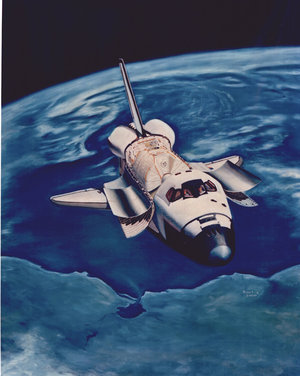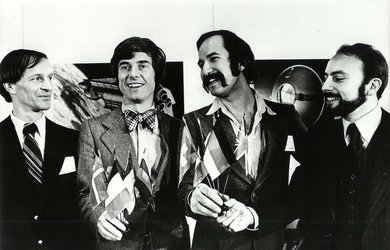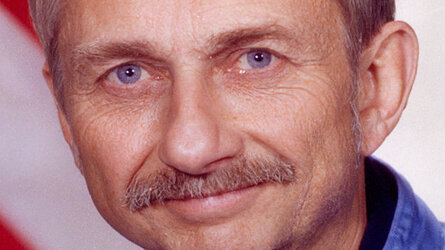Ulf Merbold: STS-9 Payload Specialist
Ulf Merbold was the first ESA astronaut to fly in space, and the first non-US citizen to fly on a Space Shuttle, as part of the crew of the STS-9 Spacelab 1 mission on Space Shuttle Columbia in 1983.

Born in 1941, Ulf Merbold’s scientific career began at age 19 when he studied physics at the University of Stuttgart. He received his Doctorate in 1976. From 1967–1978, he worked in solid-state physics at the Max Planck Institute for Metals Research.
After Spacelab-1, he flew on the Space Shuttle STS-42/IML-1 mission in 1992. Immediately after this mission, he began preparing for the Russian Euromir '94 mission in October 1994.
Euromir '94 was the first ESA mission to the Russian space station Mir, and it served primarily as the precursor to Columbus – preparing experimenters and the ground segment for the Columbus era. On this, his third spaceflight, he remained on the Mir space station for one month.
Merbold has logged 49 days in space over three missions. This is the most spaceflights for a German national, although this is not his only historic distinction. As well as the first non-US astronaut to fly on the Shuttle, Merbold was also the first ESA astronaut to fly on a Russian mission.
Excerpts from interviews in ESA Bulletins 116 (November 2003) & 146 (May 2011)
ESA: How did it feel to be selected to work on Spacelab?
Ulf Merbold
At that time it was still not certain whether human spaceflight would be accepted as a permanent programme within ESA or whether it would be terminated after Spacelab-1. There were times when I did not feel secure but it was a great endeavour. It was fascinating to work with so many different scientists, to talk to and learn from so many people from different backgrounds. Wubbo Ockels and I put our noses into all of the various fields, vestibular research, plasma research, biology, physiology, etc.
Being the first non-Americans in the US space programme was really something special. When we started training for Spacelab-1 in Huntsville, Alabama, we received a warm welcome. After all, it was also for them the first flight where they had operational responsibility, what we now call payload operation, meaning the execution of the experiments. During our two years in training, people were really eager and happy to see us. They made sure everything was more than perfect.
But in Houston you could feel that not everyone was happy that Europe was involved. Some also resented the new concept of the payload specialist ‘astronaut scientist’, who was not under their control like the pilots. We were perceived to be intruders in an area that was reserved for ‘real’ astronauts. A couple of small things made us realise that Johnson Space Center management was suspicious. Now, of course, all this has changed. I think we broke the ice and all our colleagues who came after us had much easier lives.
ESA: What was it like when you heard you would fly first?
Ulf Merbold
That was a situation of mixed feelings. Wubbo and I are close friends, we had been working together for two years in Huntsville, and at the end of the training in the Marshall Space Flight Center we knew that only one of us could be the first. However, when the German government decided to fly the German D1 mission, they promised that the astronaut serving as back-up for Spacelab-l would fly on Dl, so in the end it was not that complicated because we both had the guarantee that we would fly.
In Huntsville, we had been working with the computer system that simulated the complete Spacelab-l configuration, scientific experiments and potential problems. We had the same knowledge, and in the end the investigators working group had to take the decision between the two of us and their recommendation was in my favour. Of course I was happy, but I would have preferred to have the opportunity to share the experience with him.
After all these years I am still grateful to Wubbo that he, after a very short moment of frustration, accepted to be the back-up and to do his utmost to make Spacelab-1 a successful flight. The success of this mission was also a boost to continue with D1. After my flight, Wubbo and I went straight into training for the next mission, this time with reversed roles.
ESA: Can you describe your training?
Ulf Merbold
As a crew we had different roles. For some experiments, we were merely lab technicians we put materials sealed in cartridges into furnaces, heated and melted materials, pushed buttons and started computer programs. In other cases we were in scientific control of the experiments, and some of them were almost artistic, for example a silicon crystal experiment in a furnace called the Mirror Heating Facility. The investigator taught us to observe the liquid zone of the crystal rod, make an assessment of how long it would take until it would become unstable, what the material should look like and what to expect to be able to judge the next step.
These experiments had many functional objectives and, after a lot of training, the experimenters gave us carte blanche. “You have control because you know as much as we do, use your sense,” they said. Of course this kind of relationship has two sides: we were proud that they trusted us, but we also felt a huge responsibility.
ESA: How was life on board?
Ulf Merbold
It was marvellous. Spacelab was a very comfortable lab, and it is sad that NASA stopped with it after roughly 20 flights and switched to Spacehab. Spacelab worked perfectly, it was quiet, had a good life support system, super air quality, nice illumination and other fantastic features, for example the airlock through which we could transfer experiments into space and back into the lab.
There was also a high-quality optical window in the ceiling of the module, so you could turn the Shuttle so that the window faced Earth for an undisturbed view. A camera system took distortion-free pictures, and in the few free moments between experiments we had breathtaking views through the viewports.
Next to all the other impressions, the views are what make an astronaut’s life an incredible experience. Earth is incredibly beautiful, and so are the stars in the black sky, the Sun in the black sky...
ESA: Was the Spacelab programme was worthwhile for Europe?
Ulf Merbold
Absolutely no question: yes! Without it we would not be where we are. Being a valid partner in the International Space Station would be inconceivable if Europe had not qualified as a partner in the Spacelab programme.














